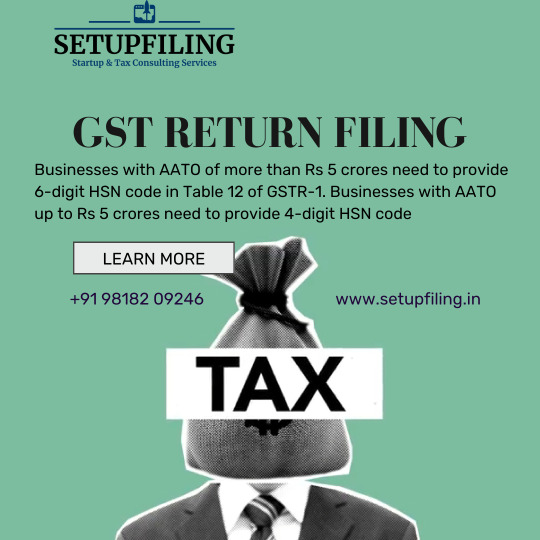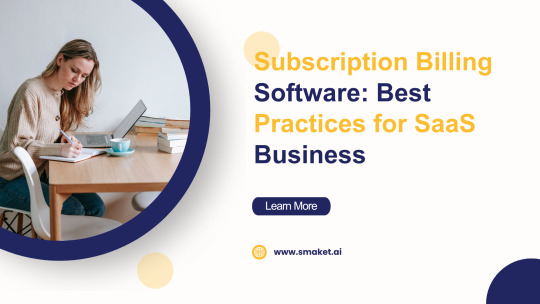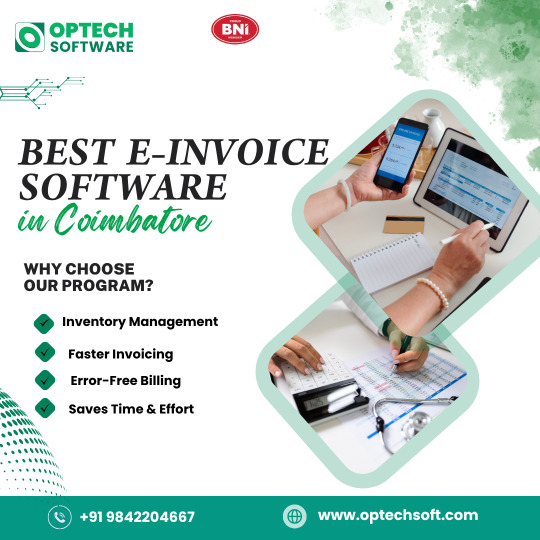#GST billing software
Explore tagged Tumblr posts
Text
🧾 GST Billing & Invoicing Software – The Ultimate Solution for Small Businesses in India
In today’s fast-paced business world, managing GST invoices, stock, and accounts manually is not only time-consuming but prone to errors. This is where a smart GST Billing & Invoicing Software comes to your rescue.
Whether you run an optical store, retail shop, or small business — using automated GST software can save hours and boost productivity.

✅ Why You Need GST Billing Software
1. 100% GST Compliant Invoices - Create professional invoices with your GSTIN, HSN/SAC codes, and automated tax calculations — in seconds.
2. E-Invoice Generation - Connect directly with the GSTN portal for seamless e-invoicing and avoid penalties.
3. Integrated Stock & Inventory Management - Track your real-time stock levels, product batches, expiry dates, and low stock alerts — all from your billing screen.
4. Sales, Purchase, & Return Management - Handle sales orders, purchase orders, quotations, and returns with one-click conversion to invoices.
5. Tally Integration & Accounting - Export reports directly to Tally ERP and simplify your accounting process.
🔍 Top Features of GST Billing & Invoicing Software
📦 Inventory & Stock Control
💳 POS System for Fast Billing
🧾 GST Reports: GSTR-1, GSTR-3B, GSTR-9
📈 100+ Business Reports (Profit & Loss, Stock, Sales)
🧑💼 Multi-user Access with Role Permissions
☁️ Cloud Backup & Data Security
📱 Mobile & Desktop Compatible
👨💻 Who Is It For?
This software is ideal for:
🕶️ Optical Shops
🛍️ Retail Stores
🏥 Pharmacies
🧰 Hardware Shops
📚 Book Stores
🏬 Small & Medium Enterprises (SMEs)
🚀 Boost Business Efficiency Today!
Switching to a Partum GST billing software is not just about compliance — it’s about scaling your business smartly. With built-in automation, detailed reports, and error-free invoicing, your daily operations become faster and smoother.
📞 Book your FREE demo now! ✅ No credit card needed ✅ 17+ Software packages ✅ Trusted by 5,000+ businesses
youtube
#gst billing software#InvoicingSoftwareIndia#BillingAndInventory#RetailBilling#EInvoiceIndia#TallyIntegration#Youtube
2 notes
·
View notes
Text
GST Registration In Jaipur

The concept of virtual offices comes as a great advantage in today’s competitive business world. It provides ample opportunity for companies to tend towards a professional image, sans the costs and commitments associated with leasing and maintaining a real office. Virtual offices seem particularly best suited to the needs of startups, small businesses, and freelancers who desire a legitimate business address for official use without bearing the overheads. Best Desk Cove Premium Virtual Office provides a perfect solution located in one of the premium locations, having robust services at cost-effective plans for businesses in Jaipur who want to get registered under GST or incorporate their companies. In this article, we are going to review why Best Desk Cove is the best virtual office provider for GST and Company registration in Jaipur.
The Advantages of a Virtual Office for GST and Company Registration in Jaipur
Virtual offices provide businesses with a professional address for all their official purposes without them having to physically rent space. The Indian regulations consider a business address to be one of the primary requirements for GST registration, and a good and credible address adds to the Company Incorporation process. Hence, this can dramatically serve in improving a business’s credibility with all sorts of clients, investors, and regulatory authorities. Best Desk Cove offers companies in Jaipur a chance to reduce overhead costs. They provide essential services such as handling mail, answering calls, and offering meeting rooms when needed. This support helps businesses operate efficiently and effectively. This is because it can offer a company a professional view and at the same time keep such a setup simple so that no hassles are faced at the time of GST registration and incorporation.
Why Jaipur is a Strategic Location for Virtual Offices
The capital of Rajasthan, Jaipur is also emerging as a key business hub by blending its age-old cultural heritage with modern infrastructure. Besides being one of the most ardent tourism and trade centers, Jaipur is also proving economical for new ventures owing to relatively lower real estate prices compared to metropolitan cities. The strategic position of the city in North India provides excellent connectivity and growing digital infrastructure, thus making it the most appealing entrepreneurship hub starting on a small scale, too, up to established companies. Setting up a virtual office in Jaipur, therefore, enables tapping into this vibrant market. Best Desk Cove Premium Virtual Office amplifies this with a prestigious address in a prime Gst Filing Through Virtual Office business district. More so, the combination with Best Desk Cove will let the company draw power from the vibrant ecosystem at Jaipur, build a professional presence, and find support in GST Registration In Jaipur and company incorporation.
#gst virtual office#gstreturns#gstfiling#gst billing software#gst registration#best gst registrations in jaipur#gst registration near me
2 notes
·
View notes
Text
Availment of ITC under GST
GST (Goods and Services Tax) is a comprehensive indirect tax levied on the supply of goods and services in India. It is a destination-based tax, which means that the tax is collected by the state where the goods or services are consumed. Under GST, the input tax credit (ITC) is an important concept that allows businesses to reduce their tax liability by claiming credit for the taxes paid on their purchases.
In this article, we will discuss everything you need to know about the availment of ITC under GST. We will cover the basics of input tax credit, the conditions to claim ITC, the documentation required, and the time limit for claiming ITC.
What is Input Tax Credit (ITC)?
Input tax credit (ITC) is the credit that a business can claim for the tax paid on its purchases used for business purposes. The tax paid on input goods or services can be set off against the output tax liability (i.e. tax payable on sales) of the business. This helps businesses reduce their tax burden and improve their cash flow.
For example, if a manufacturer,
To continue reading click here
For more detailed inofrmation, visit Swipe Blogs
2 notes
·
View notes
Text
Annual Return filling- A complete guide
Introduction
From July 1, 2017, India's GST (Goods and Services Tax) has replaced various indirect taxes imposed by the state and federal governments. Every financial year, registered taxpayers must submit a complete GST annual return. According to the Goods and Services Tax Act, a yearly return must be filed with the government. GST aims to convert the entire nation into a single market.
If you are new to GST and eager to know how this new tax will affect you and your business, how to file annual returns, and other related topics, this section will help you understand the basics of annual return filing.

What is the GSTR-9?
GSTR 9 is a yearly return to be filed annually by taxpayers registered under GST and includes details regarding the outward and inward supplies made and received during the relevant financial year under different tax heads, i.e., CGST, SGST & IGST, and HSN codes. Although it is a complex process, this return helps in the extensive data reconciliation for 100% transparent disclosures. The last date to submit the GSTR 9 form is December 31 from the subsequent financial year.
Types of GSTR-9
There are four types of GSTR-9 annual returns under the GST law.
GSTR 9- It comprises registered taxpayers who file GSTR- GSTR-2, GSTR-3, and GSTR 3B
GSTR-9A- Registered and composite dealers come under this.
GSTR-9B- It includes e-commerce dealers
GSTR-9C- It is an audit form that has to be filed by all the companies with a turnover crossing ₹2 Crores in a financial year.
Who should file GSTR-9, the annual return?
All business dealers and owners registered under the GST system must file their GST returns using applicable forms, either online or offline. However, there are some exceptions, and the list includes:
The person who falls under the "Casual Taxable Person".
The person who is not a resident of India.
Any e-commerce website or portal collecting TCS.
Penalty of late filing ITR
Every taxpayer must submit the GSTR 9 form within the given time limit. If he fails to comply with that, there is a considerable GSTR 9 penalty amount of 200 INR per day. This late fee consists of CGST 100 INR per day and SGST 100 INR per day, and there is no late fee payment on IGST. The penalty amount will not exceed the taxpayer's quarter turnover.
How does Eazybills help you file GSTR-9?
Eazybills is an online accounting software that helps you manage your finances and file GST returns.
When you generate a GSTR-9 summary on the GSTN, the transaction details may differ from what you've recorded in your books of accounts. When this happens, you must manually reconcile the information, which can be tedious and error-prone. With Eazybills, you can connect to the GSTN and generate a GSTR-9 summary based on the transactions you've created, then fetch the GSTR-9 summary from the GSTN and compare them to see which fields need to be updated. Once done, you can file the updated summary to the GSTN. This reduces the amount of time you spend updating your returns.
Conclusion
When submitting GST returns, taxpayers encounter technical problems, lengthy processes, and ambiguous regulations.Follow Eazybills for the latest updates, news blogs, and articles related to business tips, income tax, GST, GSTR-9, and GST returns.
#billing software#gst billing software#best billing software#invoice software#free invoice software#invoicing software#free invoicing software#software for billing#GSTR-9
1 note
·
View note
Text
Confidently File GST with Tally’s Beginner-Friendly Compliance Guide
Feeling overwhelmed by GST? Tally Solutions’ comprehensive GST compliance guide empowers beginners to file with clarity and accuracy. It walks you step by step through registration thresholds and invoice preparation, teaching you how to correctly handle IGST, CGST, and SGST. The guide demystifies crucial filings like GSTR‑1 and GSTR‑3B with practical examples, helping you avoid common mistakes.
What sets this guide apart is its actionable approach—showing you how to reconcile Input Tax Credit (ITC) using portal data, resolve mismatches before filing, and record debit/credit notes accurately. You’ll also learn to manage reverse-charge mechanisms, maintain statutory records, and implement streamlined workflows that include daily sales logs and automatic reminder setups.
Ideal for small business owners working alone or with minimal support, this guide helps you avoid late fees and compliance errors. By following Tally’s GST compliance roadmap, you’ll gain confidence in every filing cycle and ensure your business remains audit-ready. Ready to simplify tax filing and build strong GST habits? Check out Tally’s beginner guide today!
1 note
·
View note
Text
Optech Software offers one of the most reliable and user-friendly billing software solutions in India, designed to streamline invoicing, accounting, inventory, and GST compliance for businesses of all sizes. Whether you're a small retailer, a growing enterprise, or a service provider, our billing software ensures smooth and accurate billing operations tailored to Indian tax regulations.
#billing software#gst billing software#invoice software development bd#e-invoice#billing software in coimbatore#gst accounting software for retail#gst services#accounting services
0 notes
Text

Why Businesses with AATO of More than Rs 5 Crores Need to Provide 6-digit HSN Code in Table 12 of GSTR-1
In India, businesses with an AATO of more than Rs 5 crores are required to provide a 6-digit HSN code in Table 12 of their GSTR-1 filings
0 notes
Text
Online GST Billing Software
Are you looking for India's Best Free Cloud-Based GST Billing Software? MargBooks provides help in managing Billing, Accounting, Inventory, etc. Book your Free Demo now!
0 notes
Text
Subscription Billing Software: Best Practices for SaaS Businesses

The SaaS (Software as a Service) model thrives on predictable, recurring revenue, but managing subscription billing isn’t as straightforward as it seems. Between free trials, tiered pricing, usage-based charges, and international compliance, there’s a lot to juggle.
That’s where Subscription Billing Software comes in. The right system not only automates complex billing workflows but also ensures accuracy, compliance, and customer satisfaction.
In this article, we’ll explore best practices for using subscription billing software to help your SaaS business scale efficiently and sustainably.
Why Subscription Billing Software Matters
As your SaaS business grows, manual invoicing or generic payment tools can quickly become a bottleneck. Subscription billing software helps you:
Automate recurring payments
Handle complex pricing models (e.g., usage-based, tiered, hybrid)
Manage customer upgrades, downgrades, and cancellations
Ensure compliance with global tax and invoicing laws
Reduce churn through dunning and retry logic
Platforms like Chargebee, Recurly, Stripe Billing, Zoho Subscriptions, and Paddle are popular choices, offering robust automation, analytics, and integration capabilities.
Best Practices for SaaS Subscription Billing
1. Offer Flexible Pricing Models
Today’s customers expect choice. Offer multiple pricing tiers, freemium options, add-ons, and usage-based billing to match different needs.
2. Automate Billing and Invoicing
Manual billing is error-prone and time-consuming. Leverage automation for:
Recurring invoices
Prorated charges for mid-cycle upgrades/downgrades
Tax calculation (e.g., VAT, GST, sales tax)
Automatic renewals and receipts
3. Ensure Global Tax Compliance
If you're serving customers in multiple countries, you need to handle international tax requirements like:
EU VAT
U.S. sales tax
Australian GST
India’s GST
4. Provide a Seamless Customer Experience
A confusing checkout or billing process can drive customers away. Focus on:
Clear pricing breakdowns
Self-service portals for managing subscriptions
Easy upgrade/downgrade paths
Transparent billing history
5. Track Key Metrics and Analytics
To grow effectively, monitor critical SaaS billing KPIs like:
Monthly Recurring Revenue (MRR)
Churn rate (voluntary & involuntary)
Customer Lifetime Value (CLTV)
Average Revenue Per User (ARPU)
Net Revenue Retention (NRR)
6. Integrate With Your Tech Stack
Subscription billing should seamlessly integrate with:
CRM systems (e.g., Salesforce, HubSpot)
Accounting tools (e.g., QuickBooks, Xero)
Payment gateways (e.g., Stripe, PayPal, Braintree)
Customer support platforms
7. Prepare for Scalability
As your SaaS business grows, so will billing complexity. Choose a billing platform that:
Supports multiple currencies and languages
Can handle enterprise-level invoicing
Offers audit trails and user permissions
Provides a developer-friendly API
Choosing the Right Subscription Billing Software
When evaluating billing software, look for:
Security & compliance: PCI-DSS, GDPR, SOC 2 certifications
Customization: Ability to tailor workflows and templates
Support: Responsive customer service and documentation
Reputation: Proven track record and customer reviews
Final Thoughts
Subscription billing isn’t just a back-office function — it’s a core part of your customer journey and revenue strategy. By following these best practices and investing in the right tools, you can reduce churn, improve cash flow, and create a better experience for your customers.
In a SaaS business, billing isn’t just about collecting payments — it’s about building relationships.
0 notes
Text
Trump's Big Ugly Bill is a deal with the devil. It hikes up taxes on people making less than $50,000 while cutting Medicaid and SNAP benefits to give Elon Musk and greedy billionaires a huge tax break. You do the math. Is that worth it to you?
#usa#america#videos#video#usa is a terrorist state#usa is funding genocide#anti donald trump#donald trump#crooked donald#gucci pays rent to the trump organization#fuck trump#president trump#trump administration#trump#ausgov#politas#auspol#tasgov#taspol#australia#fuck neoliberals#neoliberal capitalism#anthony albanese#albanese government#gst registration#gst services#gst billing software#gst course#gst return filing#taxes
42 notes
·
View notes
Text
hello everybody
#gst services#gst registration#gst billing software#gst return filing#company registration#accounting services#gst course#income tax#bookkeeping#gst
0 notes
Text
GST Compliance in India: Complete Guide for Businesses
Goods and Services Tax (GST) is a unified indirect tax that has transformed the Indian taxation system. But with its dynamic framework and frequent updates, staying compliant is not just mandatory—it’s a competitive advantage.
This guide breaks down everything you need to know about GST compliance, its applicability, key processes, penalties, and answers to common questions.

What is GST Compliance?
GST compliance refers to timely and accurate adherence to all GST rules, regulations, and filing requirements under the Goods and Services Tax law. It ensures that a business:
Files returns on time
Reconciles input and output tax correctly
Issues valid tax invoices
Complies with e-invoicing and e-way bill norms
Avoids penalties, interest, and departmental notices
Who Needs to Be GST Compliant?
Businesses are required to register under GST and follow compliance provisions if they meet any of the following conditions:
Criteria
Threshold (as of current rules)
Aggregate Turnover (Goods - Normal)
₹40 Lakhs (₹20 Lakhs in special category states)
Aggregate Turnover (Services)
₹20 Lakhs (₹10 Lakhs in special category states)
Interstate supply or e-commerce
Mandatory registration irrespective of turnover
Casual taxable person / Input Service Distributor / Non-resident taxable person
Mandatory GST registration
Key Components of GST Compliance
1. Return Filing
GSTR-1 – Monthly/quarterly outward supply return
GSTR-3B – Summary return of outward and inward supplies
GSTR-9 – Annual return
GSTR-9C – Reconciliation statement (if applicable)
2. Reconciliation
Matching books of accounts with GSTR-2A/2B, GSTR-1 vs 3B
Identifying mismatches in ITC and outward tax liability
3. Input Tax Credit (ITC) Optimization
Availing eligible ITC under Section 16 of CGST Act
Ensuring suppliers have filed GSTR-1
Reversals under Rule 42, 43, or ineligible ITC
4. E-Invoicing & E-Way Bill
Mandatory for businesses with turnover > ₹5 Cr (e-invoicing)
Ensuring movement of goods is supported by valid E-Way Bills
5. Registration & Amendments
Timely registration of business
Updating PAN, address, authorized signatories on GST portal
6. Responding to Notices
Proper documentation & timely reply to notices (like DRC-01, ASMT, etc.)
Avoiding litigation through proactive compliance
Why GST Compliance is Crucial
Avoids Penalties & Interest Delayed or wrong filings attract heavy fines and interest.
Ensures Seamless ITC Flow Non-compliance by your supplier can block your input credit.
Enhances Business Reputation Clean compliance record builds trust with clients, vendors & authorities.
Prepares You for Audits & Assessments Ensures you're ready for GST audits or departmental scrutiny.
Penalties for Non-Compliance
Nature of Default
Penalty
Late filing of returns
₹50/day (₹20/day for Nil returns)
Wrong ITC claim
Interest + Penalty under Sec 73/74
Not issuing invoice
₹10,000 or amount of tax evaded (whichever higher)
Not registering under GST
100% tax due or ₹10,000 (whichever higher)
FAQs on GST Compliance
Q1. What are the due dates for GST return filing?
GSTR-1: 11th of the next month / quarterly (IFF)
GSTR-3B: 20th, 22nd, or 24th depending on state
GSTR-9: 31st December following the financial year
Q2. Is GST applicable to freelancers and consultants?
Yes. If your income exceeds ₹20 lakh (₹10 lakh in special category states), GST registration is mandatory for service providers.
Q3. Can I claim ITC if the supplier hasn’t filed GSTR-1?
No. As per Rule 36(4), ITC can only be claimed if it appears in GSTR-2B, which is populated from supplier’s GSTR-1.
Q4. Is GST applicable to export of services?
Export of services is treated as zero-rated supply under GST, but you must file LUT or claim refund of ITC or IGST.
Q5. What is the penalty for wrong ITC claim?
If claimed in good faith – interest @18% p.a. If found fraudulent – 100% penalty + prosecution under Section 74.
Final Word
GST compliance is not just about return filing. It’s about building a robust tax governance system that aligns with changing regulations, prevents revenue leakage, and keeps your business audit-ready.
With ever-increasing departmental scrutiny and real-time data integration, staying compliant is a business necessity.
#gst services#gst registration#company registration#finance#gst billing software#gst return filing#tax
0 notes
Text

Send bills on WhatsApp in seconds with Shoppeez! Smart. Simple. Instant. Book a Demo Now! 👇 https://www.shoppeez.com/demo_requests/new
#ai powered inventory software#gst billing software#retail billing software#pos software#billing software
0 notes
Text
While often used interchangeably, digital invoicing and electronic invoicing (e-invoicing) are not the same. Digital invoicing typically refers to any invoice created, sent, or stored in a digital format like PDF. E-invoicing, on the other hand, involves the structured exchange of invoice data between systems, often through automated platforms, ensuring compliance and integration. Understanding the difference is crucial for businesses aiming to streamline operations, reduce errors, and meet regulatory standards. This guide breaks down the definitions, key differences, and benefits of each approach to help you choose the right invoicing solution for your business.
#billing software#free invoicing software#invoice software#best billing software#software for billing#gst billing software#online invoicing software#invoicing software#free invoice software
0 notes
Text
Achieve Seamless Tax Compliance with TallyPrime’s Advanced GST Software
Navigate GST complexities with confidence using Tally Solutions’ powerful GST software, purpose-built to simplify every stage from invoicing to filing. Easily configure IGST, CGST, and SGST rates directly in your invoices, and let the system auto-populate tax details and ensure accuracy before submission. Its in-built e-way bill and e-invoice generation means every transaction is fully compliant and portal-ready.
With TallyPrime, tax reconciliation becomes hassle-free. Compare your purchase register to GSTR-2A data and instantly spot mismatches, helping you claim eligible input tax credits without manual effort. When it’s time to file, the software exports GSTR‑1 and GSTR‑3B in the correct JSON format—ready for instant upload—ensuring accuracy and saving time.
More than compliance, Tally’s GST software offers business insights. Dashboards display real-time summaries of tax liabilities, filing statuses, upcoming due dates, and ITC balances—helping you manage cash flow strategically. Automatic alerts for short payments, pending returns, or mismatches protect against penalties and ensure timely action.
Seamless integration with your existing accounting, inventory, and billing modules means fewer errors and consistent data flow. Regular automatic updates also ensure your system stays aligned with tax law changes. By adopting Tally’s GST software, businesses minimize compliance risks, enhance reporting clarity, and focus more on growth than on paperwork. Ready to transform your GST management? Explore TallyPrime’s advanced GST solution today!
1 note
·
View note
Text

Looking for a reliable and efficient e-invoice solution? Optech Software delivers the best e-invoice software in Coimbatore, built to meet all your GST e-invoicing needs with precision and ease. Our software is developed with powerful automation tools that simplify invoice creation, auto-generate IRNs, and ensure seamless GST portal compliance.
#gst billing software#billing software#e-invoice#invoice software development bd#billing software in coimbatore#gst accounting software for retail
0 notes